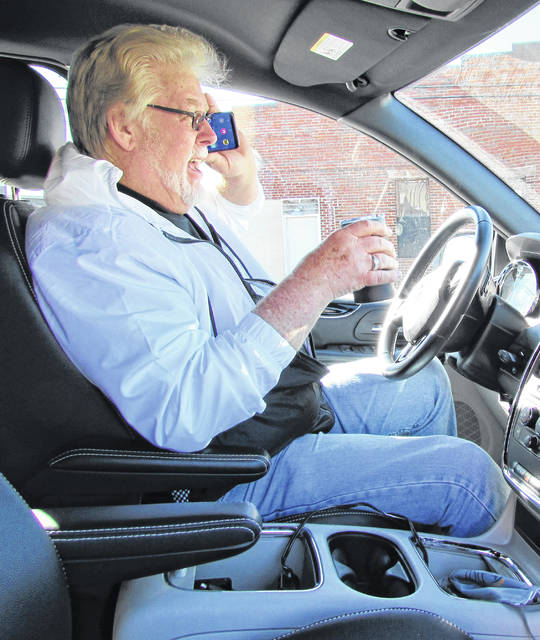
Every day in America, it kills an average of nine people and sends another 1,000 to the hospital. According to the National Highway Traffic Safety Administration (NHTSA), it’s distracted driving.
October has been designated Distracted Driving Awareness Month and Sgt. Bob Burd of the Wilmington Ohio State Highway Patrol Post told The Times-Gazette that when its crash investigations reveal distracted driving as the cause, the number one culprit is cell phone use.
“It is the absolute number one cause and it’s the most dangerous,” Burd said. “And when you think about it, when you look down to change the radio or adjusting things in the vehicle, it’s not all that interesting, but when people use their cell phones they get drawn into what they’re seeing or reading, and they just can’t or won’t look away.”
He said cell phone use in a moving car at highway speeds can escalate from a serious to a deadly issue in a matter of seconds.
Ohio State Highway Patrol data from last year showed there were 13,485 distracted-related crashes that resulted in 41 fatalities.
Statistics from AAA revealed that nationwide, nearly 3,000 people were killed in crashes involving a distracted driver, contributing to the 38,800 lives lost to incidents on U.S. roadways in 2019.
Theresa Podguski, director of legislative affairs for AAA East Central, said that distractions include more than just texting, adding that anything that diverts attention from driving such as eating and drinking, adjusting the GPS, talking to other passengers or talking or texting on the phone, could result in a fatal injury.
“We want to remind all drivers ‘don’t drive intoxicated and don’t drive intexticated,’” she said. “Distracted driving continues to be a danger to everyone, and some may feel, with the pandemic, that there’s a lower risk for crashes. But that’s really not the case.”
The auto club launched the ongoing “Don’t Drive Intoxicated, Don’t Drive Intexticated” campaign last year in Ohio and several other states to make distracted driving socially unacceptable, much like drinking and driving.
The NHTSA began to study the problem of cell phone use in cars as early as 1997 and reported that four years later, New York became the first state to pass a law banning talking on mobile phones in automobiles.
In a recent AAA Ohio survey, 58 percent of respondents said they were “very concerned” with the texting and driving problem, 61 percent claimed they never look at their phones while driving and 76 percent stated that they felt it was never appropriate to text and drive.
Yet, in that same survey 71 percent said they noticed an increase in texting and driving by other motorists.
Nearly two decades after the passage of the New York law, Podguski said it is still a persistent problem.
“Many people feel that they need that cell phone to keep in touch in many different ways,” she said. “It’s really important to set that mobile phone aside when you’re driving and concentrate on the important task of driving, because when we take our eyes off the road for even two seconds, it doubles our chances of being involved in a crash.”
She said the numbers don’t lie — at 55 miles per hour, a vehicle will travel nearly the length of a football field in just 3.5 seconds. The Centers for Disease and Control and Prevention estimates the typical driver will take five seconds to take their eyes off the road and respond to a text or phone call.
At that speed, in five seconds a vehicle will have traveled over 400 feet.
AAA supports Senate Bill 285, and said the new proposal will strengthen Ohio’s laws regarding the use of wireless devices, including smartphones, while driving.
The “Hands-Free Ohio” bill will make driving while handling any electronic wireless device a primary offense.
Currently, using a wireless device to write, send, or read a text-based communication while driving is a secondary offense for adult drivers, which means a law enforcement officer can’t pull a motorist over for only witnessing a driver texting and driving.
To avoid texting and driving, AAA recommends:
• Prepare for your drive. Set vehicle systems like GPS, seats, mirrors, climate controls and sound systems before hitting the road. Decide on the route and check traffic conditions ahead of time. And they recommend drivers — both male and female — finish dressing and personal grooming at home before getting behind the wheel.
• Don’t Drive Intoxicated. Don’t Drive Intexticated. The consequences of alcohol-impaired driving and texting while driving could be the same. The auto club said to put aside electronic distractions and never use text messaging, email, video games or internet functions, including those built into the vehicle, while driving. Stow smartphones out of sight, set it to airplane mode or activate call/text blocking features.
• Stay focused. Do not let anything divert attention, and if there is a passenger in the vehicle, enlist their help as a “designated texter.” Ask them to answer calls, respond to texts and program the navigation.
Reach Tim Colliver at 937-402-2571.


